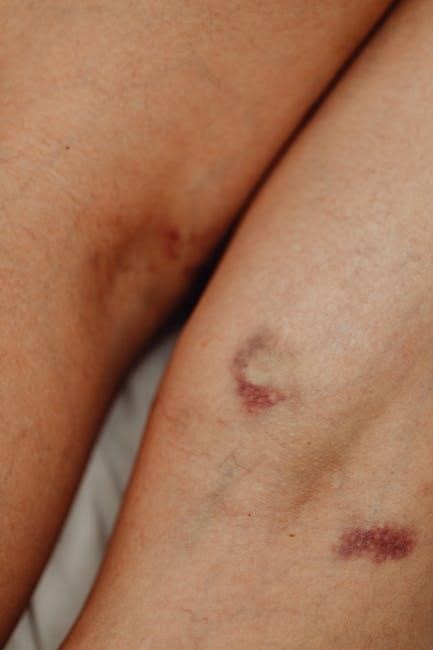
Trauma Release Exercises (TRE): An Overview
Trauma Release Exercises (TRE) are a method developed by David Berceli to help release tension and trauma. TRE activates the body’s natural response to stress.
1.1 Definition and Benefits of TRE
Trauma Release Exercises (TRE) are a somatic practice designed to release tension and trauma stored in the body. Developed by David Berceli‚ TRE activates the body’s natural shaking response‚ a mechanism that helps release physical and emotional stress. By focusing on deep muscle memory and nervous system regulation‚ TRE aims to restore balance and resilience. Benefits include reduced symptoms of PTSD‚ anxiety‚ and depression‚ as well as improved emotional regulation and overall well-being. TRE is accessible to anyone‚ offering a safe and empowering way to process trauma and tension.
1.2 The Role of David Berceli in Developing TRE
David Berceli is the originator and developer of Trauma Release Exercises (TRE). Drawing from his extensive experience in trauma recovery and natural stress responses‚ Berceli created TRE as a method to activate the body’s innate shaking response. This process helps release stored tension and trauma‚ promoting emotional and physical healing. Berceli’s work‚ inspired by observations of natural defense mechanisms in high-stress environments‚ laid the foundation for TRE’s global use. His approach emphasizes empowering individuals to self-regulate and process trauma‚ making TRE accessible to diverse populations. Berceli’s contributions have revolutionized somatic-based trauma recovery‚ offering a powerful tool for resilience and well-being.

How TRE Works
TRE activates the body’s natural shaking response to release tension and trauma‚ fostering emotional and physical healing.

2.1 The Science Behind Trauma Release
Trauma Release Exercises (TRE) are rooted in understanding the body’s neurophysiological response to trauma. Developed by Dr. David Berceli‚ TRE activates the body’s natural “tremoring” mechanism‚ which helps release stored tension. This process mimics the body’s instinctive response to stress‚ allowing the nervous system to reset and restore balance. By engaging specific muscle groups‚ TRE targets the deep tension stored in the body‚ often resulting from unresolved trauma. This approach works on the premise that unresolved trauma is stored in the muscles‚ and releasing this tension can lead to emotional and physical healing. The exercises are designed to trigger a self-regulatory response‚ reducing symptoms of PTSD‚ anxiety‚ and depression while promoting resilience.
2.2 The Role of the Nervous System in TRE
Trauma Release Exercises (TRE) work by engaging the nervous system to release stored tension. The process involves controlled muscle fatigue‚ which triggers natural tremors. These tremors help reset the nervous system‚ reducing hyperarousal and promoting relaxation. By activating the body’s innate response‚ TRE allows the nervous system to release physical tension linked to traumatic experiences. This helps restore balance and resilience‚ enabling individuals to manage stress more effectively. The exercises are designed to work in harmony with the body’s natural mechanisms‚ fostering emotional and physical healing without requiring direct confrontation of traumatic memories.

Core Activities of TRE
TRE involves seven core exercises and muscle stretches designed to activate natural tremors‚ releasing tension and promoting healing. These activities focus on specific muscle groups to induce therapeutic shaking‚ helping the body release stored trauma and restore balance.
3.1 The Seven Core Exercises
The seven core exercises in TRE are designed to target specific muscle groups‚ inducing therapeutic tremors that release stored tension. These exercises‚ including leg tremors and chest openers‚ help activate the body’s natural response to trauma. By gently fatiguing muscles‚ TRE encourages the nervous system to release deep-seated stress. The exercises are simple‚ yet powerful‚ promoting relaxation and reducing physical symptoms of trauma. They are typically performed in a sequence‚ allowing the body to gradually release tension. The goal is to restore balance and resilience‚ empowering individuals to manage stress and trauma effectively. Regular practice enhances overall well-being and emotional stability.
3.2 Muscle Stretches and Their Significance
Muscle stretches in TRE are crucial for preparing the body for tension release. They target specific areas where trauma is often stored‚ such as the hips‚ shoulders‚ and lower back. By gently stretching these muscles‚ individuals create an environment for therapeutic tremors to emerge. The stretches enhance flexibility and reduce rigidity‚ allowing the nervous system to process and release pent-up energy. This process not only alleviates physical discomfort but also promotes emotional relaxation. The significance lies in their ability to reconnect the body with its natural healing mechanisms‚ fostering resilience and overall well-being. Regular stretching complements the exercises‚ ensuring a holistic approach to trauma recovery.

Applications of TRE
TRE is widely used for PTSD‚ anxiety‚ and depression‚ offering a natural way to release stored tension. It helps individuals process trauma and restore emotional balance.

4.1 TRE for PTSD
Trauma Release Exercises (TRE) have been widely recognized as an effective tool for managing PTSD. By activating the body’s natural tremor response‚ TRE helps release stored tension related to traumatic events. This process allows individuals to process and integrate traumatic memories‚ reducing symptoms like hypervigilance and emotional reactivity. TRE is particularly beneficial for PTSD as it bypasses the need for verbal communication‚ making it accessible for those who struggle to articulate their experiences. Regular practice can lead to improved emotional regulation‚ enhanced resilience‚ and a significant reduction in PTSD symptoms‚ fostering a greater sense of safety and well-being.
4.2 TRE for Anxiety and Depression
Trauma Release Exercises (TRE) offer a powerful tool for alleviating symptoms of anxiety and depression. By releasing deep-seated tension‚ TRE helps restore balance to the nervous system‚ reducing chronic stress and emotional reactivity. The exercises promote relaxation‚ improve mood‚ and enhance overall well-being. For individuals struggling with anxiety‚ TRE can reduce hypervigilance and groundedness‚ fostering a sense of safety. Similarly‚ for depression‚ TRE can help release emotional blockages and rekindle vitality. Regular practice of TRE complements traditional therapies‚ providing a somatic approach to healing and empowering individuals to manage their mental health more effectively. This makes TRE a valuable adjunct to conventional treatments for anxiety and depression.

Incorporating TRE into Therapy
TRE is a valuable therapeutic tool‚ helping professionals empower clients to naturally release tension and regulate emotions‚ enhancing resilience and promoting healing.
5.1 Guidance for Mental Health Professionals
TRE offers a somatic approach to trauma recovery‚ empowering professionals to help clients release tension and regulate emotions. Mental health practitioners can integrate TRE into therapy by guiding clients through the exercises and monitoring their responses. It is essential to provide a safe environment‚ encouraging clients to listen to their bodies and honor their boundaries. Professionals should receive proper training in TRE to ensure effective and ethical practice. TRE can complement traditional therapies‚ offering clients a tool for self-regulation and stress management. By incorporating TRE‚ professionals can support clients in processing traumatic experiences and enhancing overall resilience and well-being.
5.2 Evidence-Based Guidelines for TRE
Trauma Release Exercises (TRE) are supported by research as an effective method for reducing stress and trauma. Studies suggest that TRE activates the body’s natural trembling response‚ aiding in tension release. Mental health professionals should follow evidence-based guidelines‚ ensuring clients are assessed for suitability before starting TRE. Proper training and supervision are crucial to safely implement the exercises. Clients should be guided to listen to their bodies and stop if discomfort arises. Research indicates TRE can complement traditional therapies for PTSD‚ anxiety‚ and depression. However‚ further studies are needed to expand its evidence base. Professionals must stay informed about the latest findings to provide optimal care.

Safety and Precautions
Always consult a healthcare professional before starting TRE‚ especially for those with severe physical or emotional conditions. TRE may not be suitable for everyone.
6.1 When to Seek Professional Help
It is crucial to seek professional help if you experience severe psychological symptoms or physical discomfort during or after practicing TRE. If you have a history of trauma‚ PTSD‚ or serious mental health conditions‚ consulting a licensed therapist or healthcare provider is essential. They can guide you in safely integrating TRE into your healing process. Additionally‚ if you notice persistent distress or physical pain‚ professional assistance is recommended to address underlying issues effectively. Always prioritize your well-being by seeking expert support when needed.
6.2 Contraindications for TRE
Trauma Release Exercises (TRE) may not be suitable for everyone. Certain conditions‚ such as severe physical injuries‚ recent fractures‚ or spinal issues‚ may contraindicate TRE. Individuals with acute mental health crises‚ including active PTSD or psychosis‚ should avoid unsupervised practice. TRE may also be contraindicated for those with a history of severe trauma without professional guidance. Additionally‚ individuals with epilepsy or neurological disorders should consult their healthcare provider before starting TRE. Pregnant individuals or those with chronic medical conditions should seek medical clearance. Always prioritize professional advice to ensure safe and appropriate use of TRE.
Trauma Release Exercises (TRE) offer a powerful tool for trauma recovery‚ empowering individuals to release tension and restore balance. Its future in therapy is promising.
7.1 The Future of TRE in Trauma Recovery
Trauma Release Exercises (TRE) hold significant potential as a future method for trauma recovery. Its accessibility and non-invasive approach make it a valuable tool for diverse populations. As awareness grows‚ TRE is likely to be integrated into mainstream therapy‚ offering a complementary approach to traditional methods. Its focus on somatic experiences aligns with increasing interest in mind-body therapies. With ongoing research and education‚ TRE could become a key component in holistic trauma care‚ empowering individuals to heal and regain resilience. Its simplicity and effectiveness make it a promising solution for addressing trauma globally.



